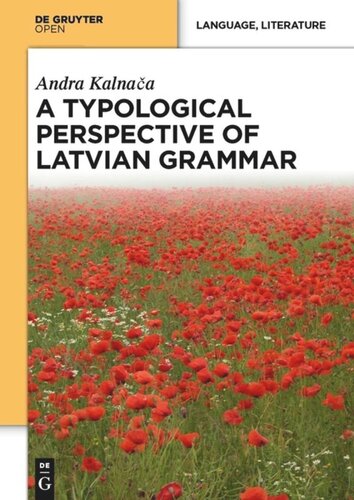

Most ebook files are in PDF format, so you can easily read them using various software such as Foxit Reader or directly on the Google Chrome browser.
Some ebook files are released by publishers in other formats such as .awz, .mobi, .epub, .fb2, etc. You may need to install specific software to read these formats on mobile/PC, such as Calibre.
Please read the tutorial at this link: https://ebookbell.com/faq
We offer FREE conversion to the popular formats you request; however, this may take some time. Therefore, right after payment, please email us, and we will try to provide the service as quickly as possible.
For some exceptional file formats or broken links (if any), please refrain from opening any disputes. Instead, email us first, and we will try to assist within a maximum of 6 hours.
EbookBell Team

5.0
38 reviewsTheoretical studies of Latvian grammar have a great deal to offer to contemporary linguistics. Although traditionally Lithuanian has been the most widely studied Baltic language in diachronic and synchronic linguistics alike, Latvian has a number of distinctive features that can prove valuable both for historical, and perhaps even more so, for synchronic language research. Therefore, at the very least, contemporary typological, areal, and language contact studies involving Baltic languages should account for data from Latvian. Typologically, Latvian grammar is a classic Indo-European (Baltic) system with well-developed inflection and derivation. However, it also bears certain similarities to the Finno-Ugric languages, which can be reasonably explained by its areal and historical background. This applies, for example, to the mood system and its connections with modality and evidentiality in Latvian, also to the correlation between aspect and quantity as manifested in verbal and nominal (case) forms. The relations between debitive mood, certain constructions with reflexive verbs, and voice in Latvian are intriguing examples of unusual morphosyntactic features.
Accordingly, the book focuses on the following topics: case system and declension (with emphasis on the polyfunctionality of case forms), gender, conjugation, tense and personal forms, aspect, mood, modality and evidentiality, reflexive verbs, and voice. The examples included in this book have been taken from the Balanced Corpus of Modern Latvian (Lidzsvarots musdienu latviešu valodas tekstu korpuss, available at www.korpuss.lv), www.google.lv, mass media, and fiction texts (see the List of language sources) without regard to relative frequency ratios.
Latvian Grammar